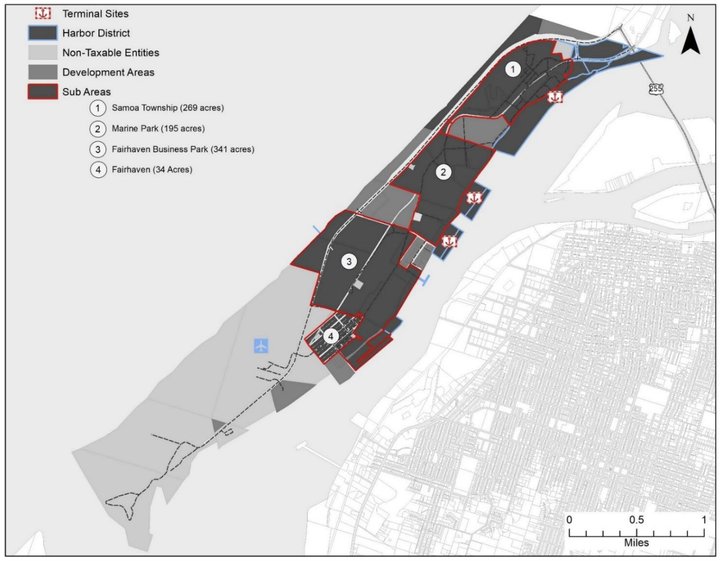
Map of draft boundaries for the Enhanced Infrastructure Financing District (EIFD) on the Samoa Peninsula. | Image via County of Humboldt.
###
A lot is happening out on the Samoa Peninsula. You’ve got the Samoa Town Master Plan, a major residential, commercial and light industrial project being built by Danco. You’ve also got Nordic Aquaculture’s land-based Atlantic salmon farm, which is in the late planning stages. Plus there’s the transpacific fiber optic cable that will connect Humboldt to Asia, major offshore wind development potential and more.
Impressive. But in a presentation nestled into the Board of Supervisors meeting on Tuesday, staffers in the county’s Economic Development Division said the peninsula’s true potential has been stifled over the years by economic barriers and inadequate infrastructure.
“The county has been trying to come up with a solution to this for quite some time,” said Tanner Etherton, an administrative analyst in Economic Development. After holding community workshops, stakeholder meetings and conducting outreach and research, the county believes it has found that solution. It’s called an Enhanced Infrastructure Financing District (EIFD).
The name may not be sexy, but Etherton explained that this economic tool — a form of tax increment financing — can capture the value of future development, using bond revenues backed by projected property tax increases to fund investments in community infrastructure, effectively jump-starting economic development on the 2,443-acre land mass south of the Samoa Bridge.
At Tuesday’s meeting, staff presented a draft Infrastructure Financing Plan (IFP) and offered an overview of how the program would work, but no formal action was taken. In the coming months, at least three public hearings will be held to hear and incorporate community feedback before the Board of Supervisors gets asked to formally establish the EIFD.
The district will be governed by a Public Finance Authority (PFA). (Yes, government loves those acronyms.) This particular PFA, which the board agreed to form in June, is comprised of three supervisors (Rex Bohn, Virginia Bass and Mike Wilson) along with two members of the public, Tim Callison and Christopher Drop.
The county calculates that there’s currently about $49.5 million in assessed value on peninsula properties. With help from the EIFD, Economic Development staff says that could balloon to about $724.7 million in new development value over the next decade.
“We found that implementation of the EIFD has long-lasting, community-wide significance, which promotes economic prosperity, achievement of energy goals, promotion of environmental sustainability, increasing jobs and enhancement of quality and place of life in Humboldt County,” Etherton said.
In a PowerPoint presentation, he offered a list of anticipated regional benefits:
- $52.8 million in net fiscal impact to County over 50 years (on a present-value basis)
- 198 housing units within the District
- 7,088 direct, indirect, and induced temporary, construction job years over the construction period
- 805 direct, permanent jobs in the County
- 987 additional indirect and induced permanent jobs in the County (total of 1792 direct, indirect, and induced jobs)
- $989.1 million in economic output from construction in the County
- $261.1 in annual ongoing economic output in the County.
“And the big question is, ‘What are the funds going to be used for?’” Etherton said. He cited wisdom imparted by his boss, Economic Development Director Scott Adair, saying, “When we think of economics and infrastructure we often think of factories and cities, and even smokestacks, but it’s important to note EIFD can fund a variety of projects, most of which are geared towards sustainable development.”
The California Center for Rural Development up at HSU conducted interviews with stakeholders to find out what people want to see out on the peninsula, and the resulting wish list included water system infrastructure upgrades, green energy opportunities and development incentives such as advanced permitting and the placement of easements.
Etherton presented a spreadsheet showing an extensive list of proposed facilities, ranging from solid waste disposal and mass timber manufacturers to affordable housing, libraries, child care facilities and more.
The mechanics of EIFD funding are a bit complex. Etherton explained that for every dollar of incremental property tax available, the financing district will receive approximately 12.75 cents. There’s also money available via incremental property taxes in lieu of motor vehicle license fees. The financing district would get 10.5 cents of every dollar there.
“This gives the fund a total annual revenue of $1.8 million by year 10 [and] a cumulative revenue of $30.1 million by year 20. Based on this information, by just year five the EIFD could have a bonding capacity of 9.4 million, which it could issue and start paying for infrastructure at an earlier date.”
The financing district will also be leveraged to seek grant funding from the state and feds. The issuance of bonds will require 55 percent voter approval. But the takeaway on Tuesday was that this new stream of revenue has potential to transform the Samoa Peninsula in the coming years with vast improvements to infrastructure and economic development.
The next public hearing of the Public Financing Authority is scheduled for December 14 at 10:30 a.m. with two more planned for February and March.
CLICK TO MANAGE